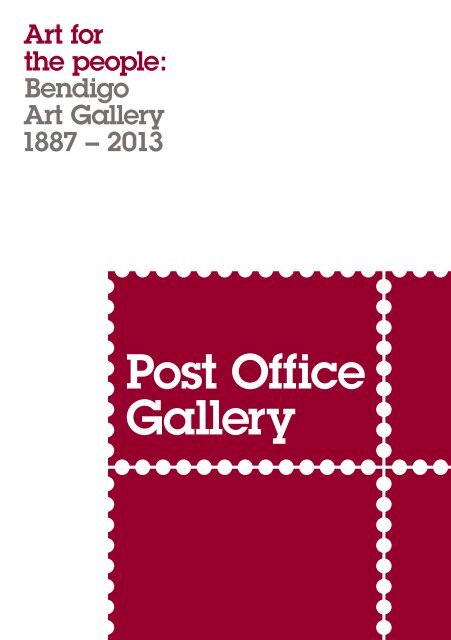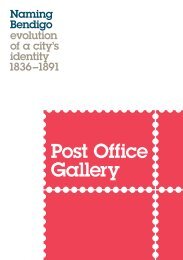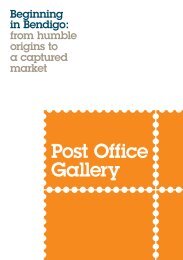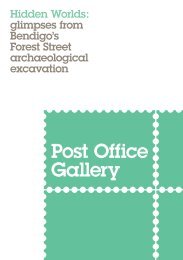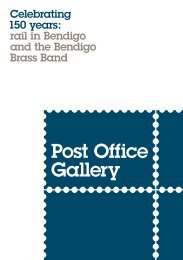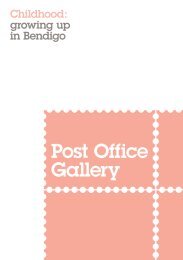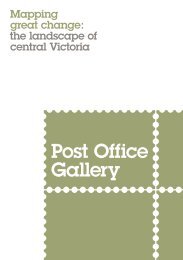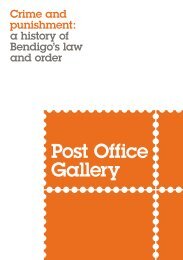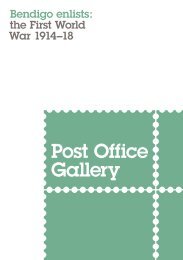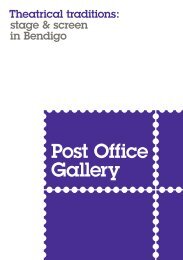Art for the People: Bendigo Art Gallery 1887 - 2013
This electronic publication accompanies the exhibition Art for the People: Bendigo Art Gallery 1887 - 2013. Bendigo Art Gallery, established in 1887, has played, and continues to play an important role in the local Bendigo community. The Gallery has existed for the delight of the people since a desire for a Gallery was expressed in Mayor P Hayes letter (11 May 1887) to the principal citizens to ‘prove of great service to the young people growing up around us’. Considered a cultivating and educating strength of the community, the Gallery endeavours to collect, preserve and display works of art … for the pleasure and education of the public. In more recent years it has positioned itself as the most profiled and significant cultural venue in regional Australia. Drawing on the archives of Bendigo Art Gallery, this exhibition was curated to offer a glimpse into the story and journey so far of this much loved and respected people’s gallery.
This electronic publication accompanies the exhibition Art for the People: Bendigo Art Gallery 1887 - 2013.
Bendigo Art Gallery, established in 1887, has played, and continues to play an important role in the local Bendigo community. The Gallery has existed for the delight of the people since a desire for a Gallery was expressed in Mayor P Hayes letter (11 May 1887) to the principal citizens to ‘prove of great service to the young people growing up around us’. Considered a cultivating and educating strength of the community, the Gallery endeavours to collect, preserve and display works of art … for the pleasure and education of the public. In more recent years it has positioned itself as the most profiled and significant cultural venue in regional Australia. Drawing on the archives of Bendigo Art Gallery, this exhibition was curated to offer a glimpse into the story and journey so far of this much loved and respected people’s gallery.
Create successful ePaper yourself
Turn your PDF publications into a flip-book with our unique Google optimized e-Paper software.
<strong>Art</strong> <strong>for</strong><br />
<strong>the</strong> people:<br />
<strong>Bendigo</strong><br />
<strong>Art</strong> <strong>Gallery</strong><br />
<strong>1887</strong> – <strong>2013</strong><br />
1
a satellite space of<br />
<strong>Bendigo</strong> <strong>Art</strong> <strong>Gallery</strong><br />
42 View Street<br />
<strong>Bendigo</strong>, Victoria 3550 Australia<br />
www.bendigoartgallery.com.au<br />
Published <strong>2013</strong><br />
Copyright © <strong>Bendigo</strong> <strong>Art</strong> <strong>Gallery</strong> <strong>2013</strong><br />
This work is copyright. Apart from any use as permitted under<br />
<strong>the</strong> Copyright Act 1968, no part may be reproduced by any<br />
process without prior written permission.<br />
Typeset and printed in Australia by <strong>Bendigo</strong> Modern Press<br />
www.bmp.com.au<br />
National Library of Australia<br />
Cataloguing-in-Publication data:<br />
Bloomfield, Simone<br />
<strong>Art</strong> <strong>for</strong> <strong>the</strong> people: <strong>Bendigo</strong> <strong>Art</strong> <strong>Gallery</strong> <strong>1887</strong>-<strong>2013</strong><br />
Simone Bloomfield, Karen Quinlan, photographer Ian Hill.<br />
ISBN: 9780949215734 (pbk)<br />
<strong>Bendigo</strong> <strong>Art</strong> <strong>Gallery</strong>--History.<br />
<strong>Art</strong> museums--Victoria--<strong>Bendigo</strong>--History.<br />
O<strong>the</strong>r Authors/Contributors:<br />
Quinlan, Karen<br />
Hill, Ian<br />
<strong>Bendigo</strong> <strong>Art</strong> <strong>Gallery</strong><br />
708.99454<br />
Exhibition venue:<br />
Post Office <strong>Gallery</strong>, 51–67 Pall Mall, <strong>Bendigo</strong>.<br />
Exhibition dates:<br />
16 August <strong>2013</strong>–27 January 2014<br />
<strong>Art</strong> <strong>for</strong><br />
<strong>the</strong> people:<br />
<strong>Bendigo</strong><br />
<strong>Art</strong> <strong>Gallery</strong><br />
<strong>1887</strong> – <strong>2013</strong><br />
Post Office <strong>Gallery</strong> and <strong>Bendigo</strong> <strong>Art</strong> <strong>Gallery</strong> are proudly<br />
owned and operated by <strong>the</strong> City of Greater <strong>Bendigo</strong>.<br />
Unknown photographer<br />
<strong>Bendigo</strong> <strong>Art</strong> <strong>Gallery</strong><br />
Media<br />
Corporate<br />
sponsor<br />
sponsor<br />
1890s<br />
<strong>Bendigo</strong> <strong>Art</strong> <strong>Gallery</strong> archives<br />
2 1
Introduction<br />
<strong>Art</strong> <strong>for</strong> <strong>the</strong> people: <strong>Bendigo</strong> <strong>Art</strong> <strong>Gallery</strong><br />
<strong>1887</strong> – <strong>2013</strong>, reflects upon <strong>the</strong> origin<br />
and evolution of <strong>Bendigo</strong> <strong>Art</strong> <strong>Gallery</strong>,<br />
coinciding with a pivotal moment in<br />
its contemporary history: <strong>the</strong> <strong>2013</strong><br />
redevelopment. Delving into <strong>the</strong><br />
archives, selected historical artefacts<br />
and materials bring to life <strong>the</strong> stories<br />
surrounding architectural developments,<br />
<strong>the</strong> founders and <strong>the</strong>ir motivation,<br />
and highlights <strong>the</strong> individuals who<br />
have given so generously from <strong>the</strong>ir<br />
own collections to create our ‘people’s<br />
gallery’.<br />
<strong>Bendigo</strong> <strong>Art</strong> <strong>Gallery</strong> was established<br />
in <strong>1887</strong> by <strong>the</strong> citizens of Sandhurst,<br />
as <strong>Bendigo</strong> was known until 1891, to<br />
encourage an appreciation of artistic<br />
culture within <strong>the</strong> <strong>for</strong>mative years of<br />
<strong>the</strong> city’s development. The township<br />
of <strong>Bendigo</strong> had already earned its<br />
reputation as a colonial success story<br />
with <strong>the</strong> discovery of gold, quickly<br />
displaying <strong>the</strong> hallmarks of an elegant<br />
Victorian city.<br />
The Sandhurst School of Mines in<br />
McCrae Street (now <strong>Bendigo</strong> Regional<br />
Institute of TAFE) was <strong>the</strong> first location<br />
<strong>for</strong> <strong>the</strong> <strong>Gallery</strong>. It subsequently relocated<br />
to <strong>the</strong> <strong>Bendigo</strong> Volunteer Rifle orderly<br />
room on View Street in 1890, and from<br />
this modest beginning <strong>the</strong> <strong>Gallery</strong> has<br />
evolved through a series of extensions<br />
and redevelopments to its current <strong>for</strong>m.<br />
For at least <strong>the</strong> first two decades of<br />
<strong>Bendigo</strong> <strong>Art</strong> <strong>Gallery</strong>’s existence, British<br />
and European academic pictures were<br />
<strong>the</strong> cornerstone of <strong>the</strong> collection. More<br />
than a century later, <strong>the</strong> collection is<br />
recognised <strong>for</strong> its diverse contemporary<br />
representation including a selection<br />
of work by <strong>the</strong> very best artists in <strong>the</strong><br />
country.<br />
<strong>Bendigo</strong> <strong>Art</strong> <strong>Gallery</strong>’s collection<br />
including paintings, sculpture, works<br />
on paper, new media and decorative<br />
art objects. The current redevelopment,<br />
designed by Karl Fender of Fender<br />
Katsalidis Architects and funded by<br />
state and local government, symbolises<br />
<strong>the</strong> bright future ahead <strong>for</strong> <strong>Bendigo</strong><br />
<strong>Art</strong> <strong>Gallery</strong>. Its growing contemporary<br />
collection, innovative programming,<br />
inspirational education and public<br />
programming, and <strong>the</strong> establishment of<br />
an international exhibition schedule that<br />
links <strong>Bendigo</strong> with <strong>the</strong> world rein<strong>for</strong>ces<br />
its capacity and reputation as <strong>the</strong> largest<br />
and most progressive museum of art<br />
within regional Australia.<br />
<strong>Bendigo</strong> <strong>Art</strong> <strong>Gallery</strong>’s lenders,<br />
volunteers and supporters are an integral<br />
part of our success. For <strong>the</strong>ir generous<br />
contribution to <strong>the</strong> exhibition <strong>Art</strong> <strong>for</strong><br />
<strong>the</strong> people: <strong>Bendigo</strong> <strong>Art</strong> <strong>Gallery</strong> <strong>1887</strong> –<br />
<strong>2013</strong>, my sincere thanks to <strong>the</strong> <strong>Bendigo</strong><br />
branch of <strong>the</strong> National Trust of Australia<br />
(Victoria), Margaret Bowden, Helen and<br />
Leo Bruinier, Rod Fyffe, Merle Hall,<br />
John Higgs, Dorothy Houlden, Erma<br />
Little, Peter and Dale Little, Stan Liacos,<br />
Jan Monro, Dennis O’Hoy, and Geoff<br />
Paynter. Thank you also to Melinda<br />
Mockridge <strong>for</strong> her invaluable assistance<br />
with research.<br />
I’d like to thank Simone Bloomfield<br />
<strong>for</strong> curating this exhibition, and <strong>the</strong><br />
technical team of <strong>Bendigo</strong> <strong>Art</strong> <strong>Gallery</strong><br />
<strong>for</strong> <strong>the</strong>ir ongoing support. A special<br />
acknowledgment must also be made<br />
of <strong>the</strong> significant contribution of our<br />
wonderful team of Post Office <strong>Gallery</strong><br />
volunteers who assist in bringing <strong>the</strong><br />
exhibitions at this venue to life through<br />
<strong>the</strong>ir interactions with visitors.<br />
Unknown artist<br />
Sandhurst Fine <strong>Art</strong><br />
<strong>Gallery</strong> when housed<br />
at <strong>Bendigo</strong> School<br />
of Mines, McCrae<br />
Street (detail)<br />
c<strong>1887</strong><br />
Karen Quinlan<br />
engraving<br />
DIRECTOR, BENDIGO ART GALLERY<br />
<strong>Bendigo</strong> <strong>Art</strong><br />
<strong>Gallery</strong> archives now comprises close to 5000 works,<br />
2 3
<strong>Art</strong> <strong>for</strong> <strong>the</strong> people:<br />
<strong>Bendigo</strong> <strong>Art</strong> <strong>Gallery</strong><br />
<strong>1887</strong> – <strong>2013</strong><br />
Ad delectationem Populi per <strong>Art</strong>em<br />
Pulchram; ‘<strong>for</strong> <strong>the</strong> delight of <strong>the</strong> people<br />
through beautiful art’. 1<br />
Originally called Sandhurst Fine<br />
<strong>Art</strong> <strong>Gallery</strong>, <strong>Bendigo</strong> <strong>Art</strong> <strong>Gallery</strong> was<br />
established in <strong>1887</strong> and since that<br />
time it has played a pivotal role in<br />
<strong>the</strong> <strong>Bendigo</strong> community. The desire<br />
<strong>for</strong> a <strong>Gallery</strong> was first expressed by<br />
<strong>the</strong> Mayor of Sandhurst, Mr Patrick<br />
Hayes, in a letter to <strong>the</strong> city’s principal<br />
citizens to ‘prove of great service to<br />
<strong>the</strong> young people growing up around<br />
us’. 2 Considered a cultivating and<br />
educating strength of <strong>the</strong> community,<br />
<strong>the</strong> <strong>Gallery</strong> has always endeavoured<br />
to collect, preserve and display works<br />
of art <strong>for</strong> <strong>the</strong> pleasure and education<br />
of <strong>the</strong> public. 3 In more recent years<br />
it has positioned itself as <strong>the</strong> most<br />
profiled and significant cultural venue<br />
in regional Australia; international<br />
exhibitions have been <strong>the</strong> drawcard<br />
<strong>for</strong> thousands, which has seen <strong>Bendigo</strong><br />
<strong>Art</strong> <strong>Gallery</strong> evolve as <strong>the</strong> <strong>for</strong>erunner of<br />
regional galleries.<br />
As with all long-standing<br />
institutions, <strong>Bendigo</strong> <strong>Art</strong> <strong>Gallery</strong>’s<br />
stories are rich in history. Since its<br />
inception, <strong>the</strong> <strong>Gallery</strong> has evolved<br />
from a humble single-room exhibition<br />
space to one of Victoria’s largest<br />
galleries. The building itself has<br />
changed considerably since <strong>the</strong> 1880s<br />
without losing ‘… its pretty and<br />
unpretentious red brick façade’. 4 Its<br />
people – both staff and volunteers<br />
– remain dedicated to providing<br />
exhibitions, programs and events<br />
of international standard while still<br />
recalling that modest yet proud motto,<br />
‘… giving delight to <strong>the</strong> people<br />
through <strong>the</strong> beauty of art’. 5 Without its<br />
founders and remarkable benefactors,<br />
<strong>Bendigo</strong> <strong>Art</strong> <strong>Gallery</strong> would not have<br />
obtained <strong>the</strong> reputation it has today.<br />
The <strong>Gallery</strong> continues to grow<br />
and includes an extensive and varied<br />
collection of painting, sculpture,<br />
ceramics, indigenous art, decorative<br />
arts, photography, works on paper and<br />
new media. The collection has a strong<br />
emphasis on 19th century European<br />
art and Australian art from <strong>the</strong> 1800s<br />
onwards, and over <strong>the</strong> past decade<br />
has developed significant holdings of<br />
contemporary Australian art. As artists<br />
emerge and develop and trends evolve,<br />
so too does <strong>the</strong> <strong>Gallery</strong>’s collection.<br />
Drawing on <strong>the</strong> archives of <strong>Bendigo</strong><br />
<strong>Art</strong> <strong>Gallery</strong>, this exhibition offers a<br />
glimpse into <strong>the</strong> stories and journey so<br />
far of this much loved and respected<br />
people’s gallery.<br />
Sandhurst Fine <strong>Art</strong><br />
Public <strong>Gallery</strong> –<br />
<strong>Gallery</strong> Committee<br />
First minutes book<br />
(detail)<br />
<strong>1887</strong>–89<br />
pen on paper<br />
<strong>Bendigo</strong> <strong>Art</strong> <strong>Gallery</strong><br />
archives<br />
THE SANDHURST FINE ART PUBLIC<br />
GALLERY<br />
‘Sandhurst is behind o<strong>the</strong>r places<br />
in not having an <strong>Art</strong> <strong>Gallery</strong>’ 6 was<br />
<strong>the</strong> sentiment expressed by Mr John<br />
Wilkinson Rymer in a letter to <strong>the</strong><br />
<strong>Bendigo</strong> Advertiser on 5 April <strong>1887</strong>.<br />
Local artist William Short agreed with<br />
Rymer and trusted that this movement<br />
would be ‘… heartily supported by <strong>the</strong><br />
art loving population of Sandhurst’, 7<br />
offering to donate a painting <strong>for</strong> <strong>the</strong><br />
cause. Popular opinion was such that<br />
it was imminent that Sandhurst would<br />
soon have ‘… an <strong>Art</strong> <strong>Gallery</strong> of which<br />
<strong>the</strong> citizens may be proud … of great<br />
advantage to <strong>the</strong> rising generation<br />
in having a highly refining influence<br />
and in developing talent … it will<br />
encourage <strong>the</strong> growth of <strong>the</strong> arts …<br />
and be a constant source of pleasure to<br />
<strong>the</strong> community’. 8<br />
In response, on 19 May <strong>1887</strong>,<br />
Mayor JP (Patrick) Hayes called a<br />
public meeting which was attended<br />
by more than 35 local representatives<br />
including doctors, lawyers, lecturers<br />
and businessmen. At that moment,<br />
Sandhurst Fine <strong>Art</strong> <strong>Gallery</strong> was<br />
born, and a provisional committee<br />
appointed. The <strong>Gallery</strong> was underway<br />
with only a few works donated by<br />
Jacob Cohn and a number of pieces<br />
lent by private citizens.<br />
Mr Rymer continued to take a great<br />
interest in <strong>the</strong> welfare of <strong>the</strong> <strong>Gallery</strong><br />
and his advice and assistance, especially<br />
in <strong>the</strong> choice of new artworks,<br />
was always freely given and keenly<br />
appreciated by his colleagues on <strong>the</strong><br />
Committee. Mr Hayes was <strong>the</strong> first<br />
President of Sandhurst Fine <strong>Art</strong> <strong>Gallery</strong>,<br />
in <strong>the</strong> same year he was Mayor, using<br />
his influence to <strong>for</strong>m <strong>the</strong> art gallery. He<br />
served as President <strong>for</strong> one year. Jacob<br />
Cohn served as <strong>the</strong> second President<br />
and held <strong>the</strong> position <strong>for</strong> 14 years.<br />
A MILITARY BEGINNING<br />
From <strong>1887</strong> to 1890 <strong>the</strong> <strong>Gallery</strong><br />
was housed in a large hall at <strong>the</strong><br />
Sandhurst School of Mines on Pall<br />
Mall (now <strong>Bendigo</strong> Regional Institute<br />
of TAFE), until building repairs and<br />
<strong>the</strong> ‘… mild outrage caused by <strong>the</strong><br />
scandalous exhibition of a nude<br />
painting, The Spanish Maiden, caused<br />
<strong>the</strong> gallery committee to seek o<strong>the</strong>r<br />
accommodation’. 9<br />
After unsuccessfully applying <strong>for</strong> a<br />
£2000 government grant in <strong>1887</strong>, and<br />
campaigning in vain to obtain <strong>the</strong> old<br />
Post and Telegraph Office on View<br />
Street as <strong>the</strong> new exhibition space,<br />
<strong>the</strong> <strong>Gallery</strong> ultimately moved to its<br />
present site – not into a purpose-built<br />
4 5
‘Residing in <strong>the</strong><br />
Orderly Room was<br />
only ever considered a<br />
temporary plan.’<br />
Mayor Patrick Hayes<br />
Letter to citizens of<br />
Sandhurst requesting<br />
attendance at a meeting<br />
to <strong>for</strong>m a picture gallery<br />
<strong>1887</strong><br />
ink on paper<br />
<strong>Bendigo</strong> <strong>Art</strong> <strong>Gallery</strong><br />
archives<br />
Unknown<br />
photographer<br />
Volunteer Rifleman’s<br />
Orderly Room during<br />
Hospital Sunday Parade<br />
1878<br />
Image from Annals of<br />
<strong>Bendigo</strong> 1851–1935,<br />
George Mackay,<br />
The Cambridge Press,<br />
<strong>Bendigo</strong>, 1938, p.163<br />
space but into <strong>the</strong> <strong>for</strong>mer <strong>Bendigo</strong><br />
Volunteer Rifle Brigade Orderly<br />
Room, built in 1867. 10 ‘The request<br />
to turn over <strong>the</strong> Orderly Room on<br />
View Street to <strong>the</strong> <strong>Gallery</strong> went to<br />
Captain Kirby of <strong>the</strong> army, who was<br />
initially unwilling ‘… because his<br />
troop was still using it.’ 11 This early<br />
Victorian building was altered to suit<br />
<strong>the</strong> <strong>Gallery</strong> by renowned local architect<br />
William Charles Vahland, (president of<br />
<strong>the</strong> School of Mines and who, with<br />
his partner Robert Getzschmann, had<br />
designed <strong>the</strong> original orderly room).<br />
Officially opened by Lord Hopetoun,<br />
Governor of Victoria, on 14 October<br />
1890, <strong>the</strong> new <strong>Gallery</strong> was modelled<br />
after detailed building specifications<br />
were sought from <strong>the</strong>n Director of <strong>the</strong><br />
National <strong>Gallery</strong> of Victoria, George<br />
Frederick Folingsby. The room was<br />
named Victoria Court to honour<br />
Queen Victoria’s Golden Jubilee year<br />
– <strong>the</strong> <strong>Gallery</strong>’s year of foundation.<br />
Today it is known as Bolton Court<br />
after William May Bolton, who was<br />
an invested figure in <strong>Bendigo</strong> <strong>Art</strong><br />
<strong>Gallery</strong> <strong>for</strong> more than 35 years. This<br />
original room within <strong>the</strong> <strong>Gallery</strong><br />
retains its architectural integrity and<br />
remains ‘… historically significant as<br />
an extraordinary example of a colonial<br />
volunteer militia building … It is an<br />
extremely rare example of a brick<br />
Volunteer orderly room.’ 12<br />
It was on 8 May 1891 that <strong>the</strong> city<br />
of Sandhurst changed its name to<br />
<strong>Bendigo</strong> following a referendum of<br />
taxpayers. In keeping with this change,<br />
Sandhurst Fine <strong>Art</strong> <strong>Gallery</strong> became<br />
<strong>Bendigo</strong> <strong>Art</strong> <strong>Gallery</strong>.<br />
Residing in <strong>the</strong> orderly room was<br />
only ever considered a temporary plan.<br />
At <strong>the</strong> time, <strong>the</strong> <strong>Gallery</strong> Committee<br />
was confident of receiving government<br />
funds to subsidise an appropriate<br />
purpose-built gallery. After Vahland<br />
sought advice and implemented <strong>the</strong><br />
adaptations of <strong>the</strong> orderly room, <strong>the</strong><br />
Committee <strong>for</strong>ged ahead with an<br />
architectural competition in 1892 in<br />
<strong>the</strong> hope of building an impressive<br />
and grand gallery <strong>for</strong> <strong>Bendigo</strong>. Emil<br />
Mauermann, ano<strong>the</strong>r local architect,<br />
was <strong>the</strong> eventual winner of this<br />
commission. In 1893 <strong>the</strong> government<br />
pledged land <strong>for</strong> this enormous<br />
columned edifice and £2500 <strong>for</strong> <strong>the</strong><br />
construction, however this pledge was<br />
soon withdrawn due to <strong>the</strong> collapse<br />
of <strong>the</strong> banks. 13 Mauermann presented<br />
a pen and ink sketch of his design – a<br />
design that was unlikely to eventuate<br />
as it was ultimately realised that ‘in <strong>the</strong><br />
6 7
Emil Mauermann<br />
(<strong>Bendigo</strong> active<br />
1880s–1900)<br />
Winning design <strong>for</strong><br />
<strong>the</strong> 1892 architectural<br />
competition<br />
1892<br />
pen and ink on<br />
cardboard<br />
Gift of <strong>the</strong> artist 1893.<br />
Collection <strong>Bendigo</strong><br />
<strong>Art</strong> <strong>Gallery</strong><br />
1893.4<br />
present state of finances of <strong>the</strong> colony<br />
<strong>the</strong>re was very little hope of <strong>the</strong> request<br />
[<strong>for</strong> a building grant] being complied<br />
with’. 14<br />
GROWTH, EXPANSION AND<br />
DEVELOPMENT<br />
Optimistic of renewed financial<br />
support in 1895, <strong>the</strong> Committee ran a<br />
design competition <strong>for</strong> new building<br />
works to extend <strong>the</strong> original orderly<br />
room, in order to house more artwork.<br />
Moved by Mr RHS Abbott at a<br />
Committee meeting in January 1896,<br />
it was decided that ‘… <strong>the</strong> successful<br />
competitor to be allowed <strong>the</strong> privilege<br />
of supervising <strong>the</strong> construction in an<br />
honorary capacity’. 15 Specifications<br />
called <strong>for</strong> a gallery, boardroom and<br />
caretaker’s quarters. 16 Controversy<br />
surrounded <strong>the</strong> competition; as a<br />
condition of entry, it was decided<br />
that <strong>the</strong> names of <strong>the</strong> local architects<br />
remain anonymous. However as noted<br />
in <strong>the</strong> Committee meeting minutes of<br />
May 1896, ‘… having been submitted<br />
to <strong>the</strong> Central Board of Health, <strong>the</strong><br />
authors [of one of <strong>the</strong> designs] …<br />
were disclosed in <strong>the</strong> communication<br />
from that body to <strong>the</strong> Committee<br />
of <strong>the</strong> <strong>Gallery</strong> … and <strong>the</strong> design was<br />
<strong>the</strong>re<strong>for</strong>e not strictly in accord with<br />
<strong>the</strong> conditions of <strong>the</strong> competition’. 17<br />
Given <strong>the</strong> error, RHS Abbott wished<br />
<strong>the</strong>ir entry to be deemed invalid but<br />
was outvoted by o<strong>the</strong>r Committee<br />
members. Eventually architects Barlow<br />
and Chandler, operating under <strong>the</strong> non<br />
de plume Reubens, were victorious.<br />
In his report President Jacob Cohn<br />
summarised <strong>the</strong> process:<br />
Competitive designs <strong>for</strong> a new<br />
building to cost between £600 and<br />
£800 were called <strong>for</strong> from local<br />
architects … Six competitors sent<br />
in some fourteen different designs.<br />
After careful consideration, <strong>the</strong><br />
competition was by vote narrowed<br />
down to two designs sent in under<br />
<strong>the</strong> pseudonyms of Reubens and<br />
Hope, and at a final selection <strong>the</strong><br />
design of Reubens was accepted.<br />
Specifications were prepared and <strong>the</strong><br />
work advertised but as <strong>the</strong> tenders<br />
received were very considerably<br />
in excess of <strong>the</strong> amount <strong>the</strong><br />
Committee proposed to expend, <strong>the</strong><br />
matter had to be referred back to <strong>the</strong><br />
architects to see what modifications<br />
could be made without impairing<br />
<strong>the</strong> original design, with instructions<br />
to re-advertise <strong>the</strong> work. This being<br />
done, <strong>the</strong> tender of Mr Sewell at<br />
£835 was accepted, and <strong>the</strong> contract<br />
duly signed… 18<br />
Unknown<br />
photographer<br />
<strong>Bendigo</strong> <strong>Art</strong> <strong>Gallery</strong><br />
facade<br />
1960s<br />
<strong>Bendigo</strong> <strong>Art</strong> <strong>Gallery</strong><br />
archives<br />
The new Drury Court was officially<br />
opened to <strong>the</strong> public on 16 June<br />
1897, its design strongly influenced<br />
by <strong>Gallery</strong> Six at Burlington House,<br />
<strong>the</strong> home of <strong>the</strong> Royal Academy of<br />
<strong>Art</strong>s. It cost £1063 to build with<br />
<strong>the</strong> new electric lighting considered<br />
a major drawcard. The new gallery<br />
received 72,000 visitors in its first year,<br />
a surprising number in a city with a<br />
population of 26,000 at <strong>the</strong> time. 19<br />
Not long after <strong>the</strong> completion<br />
of Drury Court, leading <strong>Bendigo</strong><br />
architect William Beebe was<br />
commissioned to extend <strong>the</strong> gallery<br />
again in 1905. This building project<br />
saw <strong>the</strong> addition of Alexandra Court<br />
(named <strong>for</strong> Queen Alexandra), today<br />
known as Abbott Court. The fur<strong>the</strong>r<br />
extension was considered a great<br />
success:<br />
The gallery had undergone<br />
a splendid trans<strong>for</strong>mation …<br />
Entering <strong>the</strong> building, one was at<br />
once impressed by <strong>the</strong> enhanced<br />
appearance of <strong>the</strong> old gallery, named<br />
‘Victoria Court’… it was claimed<br />
that <strong>the</strong> lighting of <strong>the</strong> gallery was<br />
comparable with that of <strong>the</strong> Tate<br />
and o<strong>the</strong>r modern galleries … The<br />
cost of <strong>the</strong> improvements in this<br />
court alone was close on £900. To<br />
<strong>the</strong> right <strong>the</strong> visitor was led on to<br />
<strong>the</strong> fine new Alexandra Court, and<br />
on <strong>the</strong> left to <strong>the</strong> Drury <strong>Gallery</strong>,<br />
both of which were excellently<br />
equipped in every way … ideas<br />
collated from <strong>the</strong> best galleries in <strong>the</strong><br />
old world and America have been<br />
harmonised and amalgamated, as it<br />
were, to suit Australian conditions,<br />
and <strong>the</strong> honorary architect (Mr W<br />
Beebe) had indeed scored a decided<br />
triumph, one in which citizens<br />
universally took pride. <strong>Bendigo</strong><br />
now boasted of one of <strong>the</strong> finest<br />
art institutions outside <strong>the</strong> State<br />
capitals. 20<br />
The next significant architectural<br />
change to occur in <strong>the</strong> <strong>Gallery</strong>’s<br />
history was <strong>the</strong> addition of a twostorey<br />
salmon-coloured brick façade,<br />
which was added to <strong>the</strong> property in<br />
1962. Behind this modernist facade, a<br />
major extension of a two-storey front<br />
wing included <strong>the</strong> Neptune Scott,<br />
Sonnenburg and Andrew Courts.<br />
Fifteen years later an eastern wing<br />
Chamberlain Court was added and was<br />
opened by <strong>the</strong> Honorable RJ Hamer,<br />
Premier of Victoria and Minister<br />
<strong>for</strong> <strong>the</strong> <strong>Art</strong>s. Also known as Buvelot<br />
Court (due to <strong>the</strong> fact it displayed<br />
<strong>the</strong> <strong>Gallery</strong>’s large and impressive<br />
8 9
Dennis Desbrowe<br />
Mayor<br />
Removal of <strong>the</strong> 1962<br />
<strong>Gallery</strong> façade<br />
1998<br />
<strong>Bendigo</strong> <strong>Art</strong> <strong>Gallery</strong><br />
archives<br />
Unknown artist<br />
Sculptural head from<br />
original <strong>Gallery</strong> façade<br />
Retrieved from work<br />
site when modernist<br />
façade was removed<br />
in 1998<br />
c1940s<br />
concrete, paint<br />
<strong>Bendigo</strong> <strong>Art</strong> <strong>Gallery</strong><br />
archives<br />
permanent collection of paintings,<br />
watercolours and drawings by Louis<br />
Buvelot, acquired through <strong>the</strong> Neptune<br />
Scott Bequest), Chamberlain Court<br />
was built with funds from <strong>the</strong> Ministry<br />
<strong>for</strong> <strong>the</strong> <strong>Art</strong>s and <strong>the</strong> estate of Miss Ivy<br />
Chamberlain.<br />
After struggling financially <strong>for</strong> many<br />
decades, in 1995 <strong>Bendigo</strong> <strong>Art</strong> <strong>Gallery</strong><br />
entered into an agreement with local<br />
government. It was decided that <strong>the</strong><br />
<strong>Gallery</strong>’s Board of Management would<br />
take charge of all artistic matters, but<br />
<strong>the</strong> <strong>Bendigo</strong> Council would undertake<br />
control of operational functions, and<br />
<strong>Bendigo</strong> <strong>Art</strong> <strong>Gallery</strong> became owned<br />
and operated by <strong>the</strong> City of Greater<br />
<strong>Bendigo</strong>. As a result, in 1996 plans <strong>for</strong><br />
new extensions and upgrades were<br />
passed: <strong>the</strong> hessian covered walls and<br />
linoleum floors, and <strong>the</strong> absence of<br />
museum systems, all required urgent<br />
attention. The adjacent ANA Motor<br />
Inn was demolished to make way <strong>for</strong><br />
a new wing of <strong>Bendigo</strong> <strong>Art</strong> <strong>Gallery</strong>,<br />
and Karl Fender of Nation Fender<br />
Katsalidis, Melbourne was appointed<br />
architect <strong>for</strong> <strong>the</strong> redevelopment. The<br />
new addition was well overdue with<br />
<strong>the</strong> <strong>Gallery</strong> facing dire problems of<br />
inadequate exhibition and storage<br />
space. The new building created a<br />
more <strong>for</strong>mal sense of entry, and each<br />
gallery was equipped with appropriate<br />
environmental control systems and<br />
monitored light levels. It was in 1998<br />
that <strong>the</strong> sculpture annexe at <strong>the</strong> rear<br />
was developed, and <strong>the</strong> ‘… cream brick<br />
veneer with little square windows … a<br />
gawky newcomer among <strong>the</strong> grand old<br />
buildings of View Street’ 21 was removed<br />
to reveal <strong>the</strong> original façade, a ‘… more<br />
sympa<strong>the</strong>tic extension leading to <strong>the</strong><br />
street’. 22 At <strong>the</strong> time <strong>the</strong> condition<br />
of <strong>the</strong> 1867 exterior was unknown,<br />
but <strong>the</strong> architects and builders were<br />
pleasantly surprised to find <strong>the</strong> 19th<br />
century building in a very sound<br />
condition.<br />
In 2001 at <strong>the</strong> conclusion of <strong>the</strong><br />
above phase of building development,<br />
fur<strong>the</strong>r extensions were completed.<br />
The Sidney Myer Work on Paper<br />
gallery and <strong>the</strong> <strong>Gallery</strong> Café were both<br />
launched.<br />
In an unusual twist of fate, <strong>Bendigo</strong><br />
<strong>Art</strong> <strong>Gallery</strong> eventually gained a space<br />
in one of <strong>the</strong> city’s oldest post offices,<br />
built in <strong>1887</strong>. Launched in November<br />
2010, Post Office <strong>Gallery</strong> is a satellite<br />
space of <strong>Bendigo</strong> <strong>Art</strong> <strong>Gallery</strong> and a<br />
City of Greater <strong>Bendigo</strong> initiative<br />
that presents changing exhibitions and<br />
events which offer insights into <strong>the</strong><br />
region’s rich and layered history.<br />
At <strong>the</strong> time of this exhibition and<br />
10 11
12<br />
Vincent Kelly<br />
(<strong>Bendigo</strong> active<br />
1904–58)<br />
RHS Abbott in his<br />
mayoral robes<br />
1917<br />
<strong>Bendigo</strong> <strong>Art</strong> <strong>Gallery</strong><br />
archives<br />
publication, <strong>Bendigo</strong> <strong>Art</strong> <strong>Gallery</strong> is<br />
again undertaking building works:<br />
Fender Katsalidis Architects have<br />
designed additional extensions<br />
that will fur<strong>the</strong>r complement <strong>the</strong><br />
<strong>Gallery</strong>’s unique position. Over <strong>the</strong><br />
past decade, <strong>the</strong> <strong>Gallery</strong> has pushed<br />
beyond <strong>the</strong> traditional boundaries<br />
of a regional gallery. With growing<br />
attendances and a continually<br />
developing collection, major works<br />
were warranted and commenced<br />
in July 2012. The redevelopment,<br />
scheduled <strong>for</strong> completion at <strong>the</strong> end of<br />
<strong>2013</strong>, includes significantly increased<br />
and updated storage and technical<br />
facilities as well as new gallery spaces.<br />
The <strong>Gallery</strong>’s three historical courts<br />
- Bolton, Drury and Abbott - are also<br />
receiving a facelift in <strong>2013</strong> with a new,<br />
more contemporary colour scheme.<br />
MAYORS, DOCTORS & HONORARY<br />
CURATORS<br />
As <strong>for</strong>mer director David Thomas<br />
noted: ‘The gallery’s founding fa<strong>the</strong>rs<br />
came from <strong>the</strong> ranks of <strong>the</strong> old<br />
diggers, who had come to <strong>the</strong> <strong>Bendigo</strong><br />
goldfields in <strong>the</strong> 50s, as well as from<br />
representatives of intellectual, political,<br />
religious, commercial and professional<br />
leaders of <strong>the</strong> town’. 23 The <strong>Gallery</strong> and<br />
its collection has been created by <strong>the</strong><br />
generosity of numerous benefactors<br />
providing assistance in many <strong>for</strong>ms.<br />
So much so, it is impossible to<br />
mention all of <strong>the</strong>m in this short essay.<br />
However, <strong>the</strong>y are not <strong>for</strong>gotten and<br />
<strong>the</strong> <strong>Gallery</strong> is <strong>for</strong>ever grateful <strong>for</strong> <strong>the</strong>ir<br />
support, <strong>for</strong>esight and philanthropy.<br />
Mentioning just a few of <strong>the</strong>se<br />
identities offers insight into <strong>the</strong> pivotal<br />
role of benefactors to <strong>the</strong> success of <strong>the</strong><br />
<strong>Gallery</strong> as a whole.<br />
Perhaps one of <strong>the</strong> best known<br />
names associated with <strong>the</strong> <strong>Gallery</strong>’s<br />
<strong>for</strong>mative years is Richard Hartley<br />
Smith (RHS) Abbott, who was closely<br />
connected with <strong>the</strong> <strong>Gallery</strong> <strong>for</strong> more<br />
than 60 years as a committee member,<br />
executive officer and devoted patron.<br />
Formerly a mayor of <strong>Bendigo</strong>, RHS<br />
Abbott was elected Honorary Secretary,<br />
a position he held from <strong>1887</strong> to 1907,<br />
after which he became President and<br />
served in that position until his death<br />
in 1940. His legacy remains one of <strong>the</strong><br />
most significant in <strong>the</strong> <strong>Gallery</strong>’s history.<br />
Upon his death in 1940, his Will<br />
stipulated that a portion of his estate be<br />
held in trust, and income from it paid<br />
in perpetuity to <strong>Bendigo</strong> <strong>Art</strong> <strong>Gallery</strong>,<br />
to be used ‘… <strong>for</strong> <strong>the</strong> promotion<br />
of art among <strong>Bendigo</strong> citizens’. 24<br />
Abbott Court – originally known as<br />
Alexandra Court when it was built in<br />
Facsimile of Dr<br />
Neptune Scott’s passport<br />
1904<br />
<strong>Bendigo</strong> <strong>Art</strong> <strong>Gallery</strong><br />
archives<br />
1905 – was later changed to honour<br />
this outstanding bequest to <strong>the</strong> <strong>Gallery</strong><br />
and thus <strong>the</strong> people of <strong>Bendigo</strong>. The<br />
<strong>Gallery</strong> continues to benefit from <strong>the</strong><br />
Abbott bequest today.<br />
George Drury, an elusive character,<br />
also left money to <strong>the</strong> <strong>Gallery</strong> in his<br />
Will. After his death in 1890, <strong>the</strong><br />
<strong>Gallery</strong> accepted <strong>the</strong> Drury bequest – a<br />
cheque of £1439 which was placed in<br />
<strong>the</strong> building fund until it was needed.<br />
Following <strong>the</strong> architectural competition<br />
in 1895 won by Barlow and Chandler,<br />
<strong>the</strong> money was drawn upon and<br />
Drury Court was opened. Little is<br />
known about George Drury and his<br />
connection to <strong>the</strong> <strong>Gallery</strong> but his<br />
generous donation has played a crucial<br />
role in <strong>the</strong> <strong>Gallery</strong>’s development.<br />
One of <strong>the</strong> <strong>Gallery</strong>’s most significant<br />
benefactors of <strong>the</strong> mid-20th century<br />
was Dr James Andrew Neptune Scott.<br />
Arriving in <strong>Bendigo</strong> in 1916, he<br />
opened a private hospital and surgery<br />
at Lister House in Rowan Street (now<br />
<strong>the</strong> Monash School of Rural Health),<br />
<strong>the</strong> income from which enabled him<br />
to indulge his passions <strong>for</strong> travelling<br />
abroad and collecting works of art. He<br />
made more than 20 trips overseas and<br />
concentrated exclusively on collecting<br />
19th century French paintings. On<br />
his death in 1944, he bequea<strong>the</strong>d 12<br />
French paintings from his collection,<br />
as selected by his wife. The remainder<br />
of <strong>the</strong> Scott collection was donated<br />
to <strong>the</strong> <strong>Gallery</strong> by Mrs CG Scott in<br />
1947, totalling 43 works including <strong>the</strong><br />
original 12. Fur<strong>the</strong>rmore, in 1953, on<br />
<strong>the</strong> death of Mrs Scott, <strong>the</strong> assets of <strong>the</strong><br />
estate became available to <strong>the</strong> <strong>Gallery</strong>.<br />
There was some question as to<br />
<strong>the</strong> au<strong>the</strong>nticity and provenance of<br />
<strong>the</strong> French paintings in <strong>the</strong> Scott<br />
collection. These works were ei<strong>the</strong>r<br />
greatly admired, or <strong>the</strong>ir au<strong>the</strong>nticity<br />
was questioned and <strong>the</strong> works<br />
ridiculed. The trouble was that nobody<br />
knew if <strong>the</strong> paintings were genuine.<br />
It seemed that some people found<br />
incredible <strong>the</strong> existence in provincial<br />
Victoria of a collection of genuine<br />
French 19th century paintings by<br />
such masters. 25 To put an end to this<br />
damaging speculation, <strong>the</strong>n Director,<br />
Doug Hall, arranged <strong>for</strong> <strong>the</strong> collection<br />
to be assessed. In 1984 French painting<br />
expert from <strong>the</strong> Louvre Madame<br />
Hélène Toussaint visited <strong>Bendigo</strong> <strong>Art</strong><br />
<strong>Gallery</strong>, <strong>for</strong> <strong>the</strong> sole purpose of assessing<br />
this collection. She found that, of<br />
<strong>the</strong> 43 works donated by Scott, four<br />
were <strong>for</strong>geries and a small number<br />
had been falsely attributed. Excitingly,<br />
several works proved to be even more<br />
significant than first thought – namely<br />
13
14 15
‘In spectacular beauty<br />
no social function<br />
held in <strong>Bendigo</strong> has<br />
exceeded it.’<br />
16<br />
Bartlett Bros (attrib)<br />
(<strong>Bendigo</strong> active<br />
1882–1940s)<br />
Subscription Ball at<br />
<strong>Bendigo</strong> Town Hall,<br />
The Daffodil Set<br />
1905<br />
<strong>Bendigo</strong> <strong>Art</strong> <strong>Gallery</strong><br />
archives<br />
works by Eugène Isabey, Alfred Sisley<br />
and Pierre Puvis de Chavannes.<br />
Funds from <strong>the</strong> Scott estate also<br />
supported <strong>the</strong> purchases of Australian<br />
paintings. In particular, watercolours<br />
and drawings by Louis Buvelot, as well<br />
as paintings by John Longstaff, Rupert<br />
Bunny, Frederick McCubbin and<br />
<strong>Art</strong>hur Streeton.<br />
Local decorative arts specialists<br />
<strong>Art</strong>hur and Jean Newson are<br />
considered two of <strong>Bendigo</strong> <strong>Art</strong><br />
<strong>Gallery</strong>’s greatest benefactors and<br />
supporters. In 1977 <strong>the</strong> Newsons<br />
donated a significant collection of 18th<br />
and 19th century porcelain, silverware<br />
and furniture. Then President BS<br />
Andrew, in a letter to <strong>the</strong> Newsons,<br />
noted that <strong>the</strong>ir contribution to <strong>the</strong><br />
<strong>Gallery</strong> meant in <strong>the</strong> ‘areas in which<br />
we were lacking in our collection<br />
… of silver, furniture and porcelain<br />
[your] generous gifts have added<br />
a magnificent contribution to our<br />
collection and filled that gap’. 26<br />
<strong>Art</strong>hur Newson was a well-known<br />
<strong>Bendigo</strong> surgeon who had a long<br />
standing connection with <strong>the</strong> <strong>Gallery</strong>,<br />
and had served on <strong>the</strong> Committee<br />
of Management from 1968 to 1977.<br />
In 1980 Jean Newson was appointed<br />
<strong>the</strong> <strong>Gallery</strong>’s first Honorary Curator<br />
of Decorative <strong>Art</strong>s. The Will of<br />
<strong>Art</strong>hur Newson provided a bequest<br />
to <strong>Bendigo</strong> <strong>Art</strong> <strong>Gallery</strong> and upon<br />
<strong>the</strong> death of Jean Newson in 1993,<br />
$289,000 was transferred to <strong>the</strong> <strong>Gallery</strong><br />
– it was <strong>the</strong> Newson’s wish that <strong>the</strong>se<br />
funds were used <strong>for</strong> acquisitions of<br />
Australian paintings of a period no<br />
later than 1940.<br />
Today <strong>the</strong> <strong>Gallery</strong> continues to<br />
benefit from generous donors. Rod<br />
Fyffe, a local philanthropist, has given<br />
munificently to <strong>Bendigo</strong> <strong>Art</strong> <strong>Gallery</strong><br />
over <strong>the</strong> past decade. His desire to<br />
build upon <strong>the</strong> <strong>Gallery</strong>’s contemporary<br />
Australian ceramics collection is<br />
reflected in <strong>the</strong> 116 (and growing)<br />
gifts and donations received over <strong>the</strong><br />
years. A well-known local identity,<br />
Fyffe has served on Council <strong>for</strong> more<br />
than 30 years, including three times as<br />
Mayor. He sits on <strong>the</strong> <strong>Gallery</strong>’s Board<br />
of Management and has done so since<br />
2009. Awarded a medal of <strong>the</strong> Order of<br />
Australia in <strong>the</strong> <strong>2013</strong> Queen’s Birthday<br />
Honours list, Rod Fyffe has said that<br />
his donations to <strong>the</strong> <strong>Gallery</strong>, volunteer<br />
and council work are ways of giving<br />
back to <strong>the</strong> <strong>Bendigo</strong> community and<br />
ensuring its prosperity.<br />
To use <strong>the</strong> words of President BS<br />
Andrew (1975–1981), ‘The standard<br />
of our collection would not have been<br />
achieved except <strong>for</strong> <strong>the</strong> donations, gifts<br />
and bequests by public and community<br />
minded persons…’ 27 It is due to <strong>the</strong>se<br />
founders, donors and supporters that<br />
<strong>the</strong> <strong>Gallery</strong> can boast its outstanding<br />
collection and continue to see it<br />
develop.<br />
HOLLYHOCKS & DAFFODILS<br />
Prior to 1995 when <strong>the</strong> City of<br />
Greater <strong>Bendigo</strong> council assumed<br />
operational control of <strong>Bendigo</strong> <strong>Art</strong><br />
<strong>Gallery</strong>, fundraising was a crucial aspect<br />
of <strong>Gallery</strong> management. Without<br />
it, building extensions, acquisitions<br />
and special events would have been<br />
impossible. As a way of boosting funds<br />
in <strong>the</strong> <strong>Gallery</strong>’s early years, annual<br />
subscription balls were organised by<br />
<strong>the</strong> wives of Committee members and<br />
held first in <strong>the</strong> <strong>Gallery</strong> and later in <strong>the</strong><br />
Town Hall.<br />
In a newspaper cutting from 1905,<br />
‘my dear Maude’ writes:<br />
The <strong>Art</strong> <strong>Gallery</strong> Ball, which<br />
everyone declares to be <strong>the</strong> prettiest<br />
thing in balls we have ever had …<br />
into what a big thing this ball has<br />
now grown! It is something that<br />
occupies <strong>the</strong> minds and energies<br />
of those who wish to <strong>for</strong>m sets <strong>for</strong><br />
weeks toge<strong>the</strong>r, and which gives<br />
drapers and tailors quite a lot to<br />
do be<strong>for</strong>ehand. But <strong>the</strong> result, of<br />
course, repays <strong>the</strong> time and energy<br />
expended. And <strong>the</strong> <strong>Art</strong> <strong>Gallery</strong><br />
committee are rubbing <strong>the</strong>ir hands<br />
toge<strong>the</strong>r in gleeful anticipation<br />
of <strong>the</strong> substantial sum that will<br />
materially assist towards paying <strong>for</strong><br />
<strong>the</strong> new building that we all like so<br />
much… 28<br />
The balls became an event <strong>the</strong><br />
whole community looked <strong>for</strong>ward<br />
to. Committees were organised to<br />
make floral sets, colour schemes were<br />
scrutinised and particular attention<br />
was given to <strong>the</strong> music provided <strong>for</strong><br />
entertainment. It was in 1905 that<br />
… <strong>the</strong> first … floral sets were<br />
introduced. The display was adjudged<br />
to be ‘grand in <strong>the</strong> extreme’ and so<br />
enamoured was everyone with its<br />
picturesqueness that popular opinion<br />
decided that sets should again<br />
be <strong>for</strong>med <strong>for</strong> <strong>the</strong> function… In<br />
spectacular beauty no social function<br />
held in <strong>Bendigo</strong> has exceeded it.<br />
Harmony of colour, appropriateness<br />
and variety of costume and<br />
decorations, were happily combined,<br />
and <strong>the</strong> effect was so enchanting as<br />
to lead dozens of onlookers, who<br />
thronged <strong>the</strong> spectators’ gallery, to<br />
go into ecstacies of delight. Adding<br />
17
18<br />
John Rowell<br />
(Australia 1894–1973)<br />
A mountain road<br />
1938<br />
oil on canvas<br />
RHS Abbott Prize,<br />
1938. Collection<br />
<strong>Bendigo</strong> <strong>Art</strong> <strong>Gallery</strong><br />
1938.4<br />
to <strong>the</strong> personal attractiveness was <strong>the</strong><br />
scenic beauty of <strong>the</strong> hall, <strong>the</strong> lights<br />
of which scintillated on <strong>the</strong> whirling<br />
and twirling dancers. Occasionally,<br />
in <strong>the</strong> waltz, a poppy popped up,<br />
and <strong>the</strong>n a violet caught <strong>the</strong> gaze.<br />
A hollyhock would spring up as if<br />
by magic, and to add to <strong>the</strong> floral<br />
variety, peach blossom would shed<br />
its pinky tints on dresses and faces<br />
and trans<strong>for</strong>m <strong>the</strong> ‘garden’ <strong>for</strong> a<br />
second or two into <strong>the</strong> ‘orchard’<br />
where in <strong>the</strong> far corner ripe corn<br />
could be seen, and a little bed of<br />
daffodils at <strong>the</strong> nearest end. About<br />
220 couples danced. The attendance<br />
was much larger that [sic] last<br />
year, and <strong>the</strong> financial result will<br />
considerably exceed <strong>the</strong> £100 <strong>the</strong>n<br />
raised. It is proposed to continue<br />
<strong>the</strong> ball annually. Stewart’s orchestra<br />
contributed <strong>the</strong> music. Mr. Reed, of<br />
Hargreaves Street, was <strong>the</strong> caterer,<br />
but <strong>the</strong> delicacies were provided by<br />
<strong>the</strong> ladies’. 29<br />
While <strong>the</strong> grand era of balls may<br />
have ended, <strong>the</strong> <strong>Gallery</strong> continues to<br />
host major fundraising initiatives. The<br />
<strong>Gallery</strong> Foundation, of which Rupert<br />
Myer is patron, was launched in 2008.<br />
It specifically works toward enabling<br />
a number of special projects to be<br />
pursued that would not o<strong>the</strong>rwise<br />
be possible within normal day-today<br />
operations of <strong>the</strong> <strong>Gallery</strong>. The<br />
Foundation supports <strong>the</strong> acquisition<br />
of art <strong>for</strong> <strong>the</strong> collection, supports <strong>the</strong><br />
participation of <strong>the</strong> community in<br />
<strong>the</strong> life of <strong>the</strong> <strong>Gallery</strong>, contributes<br />
funds to <strong>the</strong> conservation of works<br />
of art within <strong>the</strong> collection, assists<br />
educational programs and resources<br />
that will directly serve <strong>the</strong> needs of<br />
art students, boosts major exhibitions,<br />
events and special programs, endorses<br />
infrastructure, supports publications<br />
and assists <strong>the</strong> application of interactive<br />
technology. The Foundation pursues<br />
donations and directs <strong>the</strong> money as it<br />
deems appropriate.<br />
RECOGNISING TALENT<br />
From early in <strong>the</strong> <strong>Gallery</strong>’s history,<br />
art prizes have been an important tool<br />
<strong>for</strong> supporting artists and acquiring<br />
contemporary works <strong>for</strong> <strong>the</strong> collection.<br />
In 1938, two years be<strong>for</strong>e his death,<br />
<strong>the</strong> <strong>Gallery</strong> Committee recognised<br />
RHS Abbott’s many years of service<br />
by initiating an art prize in his<br />
name which included £100 <strong>for</strong> <strong>the</strong><br />
best work of fine art in painting or<br />
sculpture by an Australian artist. The<br />
sponsor of this prize was <strong>Art</strong>hur T<br />
Woodward, who was <strong>the</strong> <strong>Art</strong> Director<br />
Unknown<br />
photographer<br />
Mr AT (<strong>Art</strong>hur<br />
Thomas) Woodward<br />
nd<br />
Image from ‘Canvas<br />
to Campus’, Frank<br />
Cusack, Hawthorn<br />
Press, Melbourne.<br />
Collection Jim Evans<br />
Unknown maker<br />
AT Woodward’s<br />
paintbox (with contents)<br />
wood, metal, oil/<br />
water paint tubes<br />
c1890–1943<br />
Collection <strong>Bendigo</strong><br />
<strong>Art</strong> <strong>Gallery</strong><br />
1996.41<br />
19
‘… nothing can be<br />
more shocking than<br />
this exhibition of <strong>the</strong><br />
picture of a nude<br />
woman.’<br />
José Gutiérrez<br />
de la Vega<br />
(Spain 1791–1865)<br />
The Spanish maiden<br />
1837<br />
oil on canvas<br />
Purchased 1912.<br />
Collection <strong>Bendigo</strong><br />
<strong>Art</strong> <strong>Gallery</strong><br />
1912.12<br />
at <strong>the</strong> School of Mines.<br />
The first four prizes held by<br />
<strong>Bendigo</strong> <strong>Art</strong> <strong>Gallery</strong> were <strong>the</strong> RHS<br />
Abbott Prize in 1938, <strong>the</strong> AT Woodward<br />
Prize in 1940, <strong>the</strong> George Mackay Prize<br />
in 1942 and <strong>the</strong> Charlotte Allan Prize in<br />
1943. These prizes were named after<br />
people who had rendered particular<br />
service to <strong>the</strong> <strong>Gallery</strong> and toge<strong>the</strong>r<br />
with all subsequent prizes, were mostly<br />
financed from <strong>Gallery</strong> funds. In 1944<br />
<strong>the</strong> Victory Commemoration Prize was<br />
held, followed by <strong>the</strong> Churchill Prize<br />
in 1945 and <strong>the</strong> Victory <strong>Art</strong> Prize in<br />
1946. From 1947 this prize was held<br />
annually and known as <strong>the</strong> <strong>Bendigo</strong> <strong>Art</strong><br />
Prize; it was discontinued in 1967 and<br />
replaced <strong>for</strong> several years by <strong>the</strong> <strong>Bendigo</strong><br />
Invitation Purchase Exhibition.<br />
Today <strong>the</strong> <strong>Gallery</strong> offers two major<br />
prizes – one each <strong>for</strong> drawing and<br />
painting. The Paul Guest Prize is a nonacquisitive<br />
cash prize of $12,000 which<br />
is held every two years, highlighting<br />
contemporary drawing practice in<br />
Australia. The Prize was initiated<br />
by <strong>for</strong>mer Family Court Judge and<br />
Olympic rower, <strong>the</strong> Honourable Paul<br />
Guest QC, and encourages artists from<br />
across Australia to engage with <strong>the</strong><br />
important medium of drawing.<br />
The <strong>Art</strong>hur Guy Memorial Painting<br />
Prize was initiated by Mr Allen Guy<br />
CBE in honour of his late bro<strong>the</strong>r<br />
<strong>Art</strong>hur Guy. Also held biennially, this<br />
prize is an acquisitive cash prize of<br />
$50,000. <strong>Art</strong>hur Guy was educated at<br />
Camp Hill State School in <strong>Bendigo</strong><br />
and later at Ballarat Grammar School.<br />
He enlisted in <strong>the</strong> Royal Australian<br />
Air Force and in 1945 he was on a<br />
biscuit bomber mission when his plane<br />
was shot down near Lae, Papua New<br />
Guinea.<br />
THE OBSCENE, UNFINISHED AND<br />
MARVELLOUS<br />
Undoubtedly one of <strong>the</strong> <strong>Gallery</strong>’s<br />
most important roles is as keeper of<br />
a vast collection of Australian and<br />
international art. This impressive<br />
collection has not been without its<br />
share of controversy. Perhaps <strong>the</strong> most<br />
notorious case is that of The Spanish<br />
maiden, which was ultimately one<br />
of <strong>the</strong> reasons a permanent building<br />
was sought <strong>for</strong> <strong>the</strong> <strong>Gallery</strong> in 1890.<br />
The uproar caused by <strong>the</strong> display of<br />
this nude resurfaced in 1897 when<br />
Drury Court was first opened. The<br />
painting, by José Gutiérrez de la Vega<br />
(1791–1865) was given a prominent<br />
position in <strong>the</strong> new gallery, where it<br />
sparked renewed debate. Letters to <strong>the</strong><br />
paper resulted:<br />
… obscene and very objectionable<br />
20 21
WED Stuart<br />
(born Great Britain<br />
1826, arrived Australia<br />
1859, died 1873)<br />
Pall Mall from Bull<br />
Street<br />
c1860<br />
oil on canvas<br />
Gift of <strong>the</strong> Council of<br />
<strong>the</strong> Sandhurst School<br />
of Mines, <strong>1887</strong>.<br />
Collection <strong>Bendigo</strong><br />
<strong>Art</strong> <strong>Gallery</strong><br />
<strong>1887</strong>.1<br />
picture … nothing can be more<br />
shocking than this exhibition of <strong>the</strong><br />
picture of a nude woman. There<br />
can be no question of prudery in<br />
<strong>the</strong> presence of such a picture …<br />
but that it should be tolerated in<br />
a Christian city in <strong>the</strong> nineteenth<br />
century is deplorable … I now<br />
appeal to Christian people of all<br />
denominations to do all in <strong>the</strong>ir<br />
power to get this picture removed<br />
be<strong>for</strong>e it is <strong>the</strong> cause of more sin<br />
than it has already been <strong>the</strong> occasion<br />
of … If nothing else can be done,<br />
buy it by subscription and publicly<br />
burn it. 30<br />
<strong>the</strong>n) as it appeared in 1860. Stuart<br />
exhibited at <strong>the</strong> Royal Academy of <strong>Art</strong>s<br />
almost every year from 1846 to 1858,<br />
his paintings were mostly of flowers<br />
and fruit. Despite this international<br />
recognition he struggled throughout<br />
his career, even serving time in <strong>the</strong><br />
Sandhurst Gaol due to his inability to<br />
repay debts. It is a popularly held belief<br />
that his imprisonment could be <strong>the</strong><br />
reason <strong>the</strong> work was never completed.<br />
An example of early colonial art, Pall<br />
Mall from Bull Street is <strong>the</strong> only known<br />
scene by Stuart to survive.<br />
The breadth of stories associated<br />
with <strong>the</strong> collection is astounding and<br />
it is of course impossible to detail<br />
<strong>the</strong>m all here. Instead, a short focus<br />
on a selection of people and artists<br />
intimately linked to <strong>the</strong> <strong>Gallery</strong> is more<br />
feasible; many famous names in <strong>the</strong><br />
art world have been associated with<br />
<strong>Bendigo</strong> <strong>Art</strong> <strong>Gallery</strong>.<br />
One such example is <strong>Art</strong>hur Thomas<br />
Woodward, who was closely associated<br />
with <strong>Bendigo</strong> <strong>Art</strong> <strong>Gallery</strong> and involved<br />
in <strong>the</strong> <strong>for</strong>mation of <strong>Bendigo</strong> <strong>Art</strong><br />
<strong>Gallery</strong> Society in 1920. ‘Woodward<br />
was a generous supporter and member<br />
of <strong>the</strong> <strong>Gallery</strong> Committee <strong>for</strong> many<br />
years and regularly presented lectures<br />
on important works in <strong>the</strong> permanent<br />
collection and o<strong>the</strong>r Australian and<br />
John Walker<br />
(Australia 1878–1955)<br />
Marquette of <strong>the</strong> Robert<br />
Burns bust<br />
plaster and bronze<br />
paint<br />
c1910<br />
Gift of Mrs J Nobbs,<br />
1982. Collection<br />
<strong>Bendigo</strong> <strong>Art</strong> <strong>Gallery</strong><br />
1982.1<br />
public’. 32<br />
The English-born <strong>Art</strong> Director<br />
of <strong>the</strong> School of Mines, Woodward<br />
was ‘… an accomplished painter and<br />
teacher … with extensive training in<br />
<strong>the</strong> art schools of London, Paris and<br />
Antwerp [and] teaching experience<br />
on <strong>the</strong> staff of … Birmingham<br />
School of <strong>Art</strong>’. 33 He was known<br />
as a talented teacher and under his<br />
guidance ‘… <strong>the</strong>re emerged a group<br />
of local painters of considerable ability.<br />
Several continued <strong>the</strong>ir studies in<br />
Paris’. 34 His teaching methods and<br />
growing reputation attracted many art<br />
students. Under <strong>the</strong> expert guidance of<br />
Woodward, artists such as Ola Cohn,<br />
Madge Freeman, Agnes Goodsir,<br />
Marion Jones, Norman Penrose and<br />
John Walker developed successful<br />
artistic careers – and <strong>the</strong> <strong>Gallery</strong>’s<br />
collection holds examples of each of<br />
<strong>the</strong>se artists’ works.<br />
One of Woodward’s most celebrated<br />
students, Agnes Goodsir moved to<br />
<strong>Bendigo</strong> from Portland in 1898 to<br />
learn from this esteemed art teacher<br />
at <strong>the</strong> <strong>Bendigo</strong> School of Mines.<br />
Following encouragement from<br />
Woodward, she left <strong>for</strong> Paris to fur<strong>the</strong>r<br />
her art training, where she remained<br />
<strong>for</strong> <strong>the</strong> rest of her life. She became an<br />
established artist, exhibiting extensively<br />
at <strong>the</strong> Royal Academy of <strong>Art</strong>s and <strong>the</strong><br />
Paris Salons. The <strong>Gallery</strong>’s collection<br />
holds five works by Goodsir, including<br />
<strong>the</strong> celebrated painting Girl with<br />
Cigarette (1925). The Agnes Goodsir<br />
Archive, comprised of photographs,<br />
ephemera and art medals is also housed<br />
at <strong>Bendigo</strong> <strong>Art</strong> <strong>Gallery</strong>.<br />
John Walker, a talented local sculptor,<br />
was also trained by Woodward at <strong>the</strong><br />
School of Mines. He too studied in<br />
Paris be<strong>for</strong>e returning and settling<br />
in <strong>Bendigo</strong>. Over <strong>the</strong> course of his<br />
career he received numerous public<br />
commissions which can be viewed<br />
throughout <strong>the</strong> City of <strong>Bendigo</strong>. The<br />
bust of Scottish poet Robert Burns,<br />
made of Carrara marble, was presented<br />
in 1911 by public subscription, initiated<br />
by <strong>the</strong> <strong>Bendigo</strong> Caledonian Society<br />
and assisted by <strong>the</strong> <strong>Gallery</strong> Committee.<br />
The unveiling of <strong>the</strong> work was<br />
conducted by <strong>the</strong> Governor of Victoria,<br />
Sir Thomas Gibson Carmichael. This<br />
work was Walker’s first attempt with<br />
marble. 35 The bust is on permanent<br />
display at <strong>Bendigo</strong> <strong>Art</strong> <strong>Gallery</strong> and<br />
each year <strong>the</strong> Caledonian Society pay<br />
homage to Robert Burns by laying a<br />
wreath in his memory.<br />
Also purchased early in <strong>the</strong> <strong>Gallery</strong>’s<br />
history is <strong>the</strong> unassuming painting,<br />
Afternoon tea (<strong>1887</strong>) by Emma Minnie<br />
However, The Spanish maiden also<br />
had its admirers: considered ‘high<br />
art’ 31 it remained on display, and is<br />
now a favourite of <strong>the</strong> collection. In<br />
<strong>the</strong> 21st century it seems difficult to<br />
comprehend <strong>the</strong> initial uproar this<br />
work created.<br />
An exploration of <strong>the</strong> collection<br />
would not be complete without<br />
making note of <strong>the</strong> <strong>Gallery</strong>’s first<br />
acquisition. The first recorded<br />
acquisition is Pall Mall from Bull Street<br />
by WED Stuart (c1830–1873). A<br />
gift of <strong>the</strong> Council of <strong>the</strong> Sandhurst<br />
School of Mines in <strong>1887</strong>, this large<br />
unfinished and unsigned painting<br />
shows <strong>Bendigo</strong> (or Sandhurst as it was<br />
international collections <strong>for</strong> <strong>the</strong> general<br />
22 23
WH Robinson<br />
(<strong>Bendigo</strong> active<br />
1890s–1920)<br />
Unveiling of Robert<br />
Burns’ bust by Sir<br />
Gibson Carmichael<br />
1911<br />
Jacob Cohn (standing<br />
in second row with<br />
top hat)<br />
Mayor William Henry<br />
Wilkie (second left<br />
seated)<br />
RHS Abbott (fourth<br />
left seated)<br />
Collection Dennis<br />
O’Hoy<br />
Emma Minnie Boyd<br />
(Australia 1858–1936)<br />
Afternoon tea<br />
1888<br />
oil on canvas<br />
Purchased 1888.<br />
Collection <strong>Bendigo</strong><br />
<strong>Art</strong> <strong>Gallery</strong><br />
1888.1<br />
Boyd, acquired in 1888. It is an<br />
important work in <strong>the</strong> collection’s<br />
story as it was <strong>the</strong> first purchase of<br />
a work by a female artist. Boyd was<br />
exhibiting as a professional artist be<strong>for</strong>e<br />
she had turned 21; at this time only<br />
a few female artists could claim this<br />
standing. Ultimately becoming <strong>the</strong><br />
matriarch of an artistic dynasty, 36 Boyd<br />
exhibited at <strong>the</strong> Victorian Academy of<br />
<strong>Art</strong>s in 1875. Considered her favourite<br />
painting, 37 Afternoon tea remains<br />
a proud member of <strong>the</strong> <strong>Gallery</strong>’s<br />
permanent collection.<br />
These few works cannot of course<br />
offer a comprehensive survey, but<br />
instead offer a small insight into<br />
<strong>the</strong> diversity of a collection which<br />
holds close to 5000 works. Today <strong>the</strong><br />
<strong>Gallery</strong> is committed to collecting<br />
contemporary Australian works. The<br />
collection holds works from a range<br />
of media including painting, sculpture,<br />
works on paper, digital media and<br />
indigenous art that showcase <strong>the</strong><br />
development of Australian art and of<br />
course <strong>the</strong> continuing evolution of <strong>the</strong><br />
Australian art world.<br />
FORGING AHEAD<br />
<strong>2013</strong> marks 126 years of <strong>Bendigo</strong><br />
<strong>Art</strong> <strong>Gallery</strong> as public institution.<br />
Brought about by <strong>the</strong> need <strong>for</strong> a<br />
cultural establishment in Sandhurst,<br />
<strong>Bendigo</strong> <strong>Art</strong> <strong>Gallery</strong> continues to<br />
collect, preserve and display works<br />
of art <strong>for</strong> <strong>the</strong> pleasure and education<br />
of <strong>the</strong> public. Leaving behind any<br />
small-town quaintness and manifesting<br />
into one of <strong>the</strong> most profiled regional<br />
galleries, it now attracts exhibitions of<br />
international standard. Our <strong>Gallery</strong>’s<br />
humble beginning provides a great tale,<br />
paving <strong>the</strong> way <strong>for</strong> an institution to<br />
exist <strong>for</strong> <strong>the</strong> people, and one of which<br />
we can all be proud.<br />
Driven by exceptional and<br />
unprecedented growth in recent<br />
years, <strong>the</strong> fur<strong>the</strong>r redevelopment and<br />
expansion will provide <strong>the</strong> <strong>Gallery</strong><br />
with additional exhibition spaces, to<br />
better showcase major national and<br />
international exhibitions; accommodate<br />
increased visitor numbers; and better<br />
house and display <strong>the</strong> <strong>Gallery</strong>’s<br />
significant and growing collection.<br />
Delving into <strong>the</strong> archives of <strong>Bendigo</strong><br />
<strong>Art</strong> <strong>Gallery</strong>, this exhibition brings to<br />
light some of <strong>the</strong> unique and rarely<br />
seen items and stories from <strong>the</strong> archives<br />
of our <strong>Gallery</strong>’s past and reminds<br />
people of <strong>the</strong> story so far of <strong>the</strong><br />
treasured people’s gallery.<br />
Simone Bloomfield<br />
<strong>Bendigo</strong> <strong>Art</strong> <strong>Gallery</strong><br />
24 25
NOTES<br />
26<br />
1 A member of <strong>the</strong> <strong>Gallery</strong>’s Committee, Dr<br />
Paul MacGillivray, devised <strong>the</strong> <strong>Gallery</strong>’s<br />
motto in 1890<br />
2 Hayes, P 11 May <strong>1887</strong>, ‘Letter to <strong>the</strong><br />
principal citizens’, <strong>Bendigo</strong> <strong>Art</strong> <strong>Gallery</strong><br />
archives<br />
3 As written in <strong>the</strong> <strong>Gallery</strong>’s mission<br />
statement<br />
4 Jordan, Dr Caroline, <strong>Art</strong> Outside <strong>the</strong><br />
Metropolis: Regional Galleries in <strong>the</strong><br />
Nineteenth Century, http://www.<br />
academia.edu/1060661/<strong>Art</strong>_outside_<strong>the</strong>_<br />
Metropolis_Regional_Galleries_in_<strong>the</strong>_<br />
Nineteenth_Century), viewed June <strong>2013</strong>,<br />
unpaginated<br />
5 Thomas, David, date unknown, The Private<br />
faces of a public art gallery, <strong>Bendigo</strong> <strong>Art</strong><br />
<strong>Gallery</strong> archives, p.80<br />
6 Rymer, JW, 5 April <strong>1887</strong>, The <strong>Bendigo</strong><br />
Advertiser, p.4<br />
7 Short, William, 6 April <strong>1887</strong>, The <strong>Bendigo</strong><br />
Advertiser, p.2<br />
8 Author unknown, 14 April <strong>1887</strong>, The<br />
<strong>Bendigo</strong> Advertiser, p.2<br />
9 Thomas, David, date unknown, The<br />
Private faces of a public art gallery, <strong>Bendigo</strong><br />
<strong>Art</strong> <strong>Gallery</strong> archives, p.80. The Spanish<br />
Maiden later experienced stronger, renewed<br />
controversy which is discussed later in<br />
<strong>the</strong> context of <strong>the</strong> development of <strong>the</strong><br />
collection.<br />
10 According to Peter Ball, Vice President &<br />
Museum Curator at <strong>Bendigo</strong> & District<br />
RSL Military Museum, an army of parttime<br />
rifle, artillery and engineer corps<br />
made up of common citizens occupied<br />
<strong>the</strong> Orderly Room, utilising it as an<br />
administration office. Usually a junior<br />
ranked officer would have supervised <strong>the</strong><br />
office, a place where army personnel would<br />
come in to discuss rations or any problems<br />
<strong>the</strong>y may have had. It was also an office<br />
where businesses and groups could come<br />
to arrange an ‘honour guard’ <strong>for</strong> specific<br />
events. Phone interview 2 July <strong>2013</strong><br />
11 Jordan, Caroline, unpaginated<br />
12 150 years of Defence Forces in <strong>Bendigo</strong><br />
http://www.bendigorsl.com.au/150years/<br />
orderlyRoom.php, viewed June <strong>2013</strong><br />
13 Andrew, BS, c1975, <strong>Bendigo</strong> <strong>Art</strong> <strong>Gallery</strong> (A<br />
Short History), <strong>Bendigo</strong> <strong>Art</strong> <strong>Gallery</strong> archives<br />
14 <strong>Bendigo</strong> <strong>Art</strong> <strong>Gallery</strong> Committee, Minute<br />
book 1893 – 1899 in Jordan, Caroline,<br />
unpaginated<br />
15 <strong>Bendigo</strong> <strong>Art</strong> <strong>Gallery</strong> Committee, minutes<br />
of 6 January 1896, Minute Book Feb 1893 to<br />
1899<br />
16 The caretaker’s cottage existed on Park<br />
Lane along <strong>the</strong> entire length of <strong>the</strong><br />
<strong>Gallery</strong>. John Ashbridge Little was <strong>the</strong><br />
first caretaker from 1925 until his death<br />
11 years later. His son, Walter Fleming<br />
Little took over this position in 1936 until<br />
1963 when he suffered a heart attack<br />
while working in <strong>the</strong> <strong>Gallery</strong>. While no<br />
images survive of <strong>the</strong> caretakers cottage,<br />
Peter Little (great grandchild of John<br />
Little) remembers <strong>the</strong> cottage from his<br />
childhood. In an interview with Peter<br />
Little on 4 February <strong>2013</strong>, he recalled <strong>the</strong><br />
small residence having two bedrooms and<br />
a sleepout. There was a small office and a<br />
long narrow dining room, with a kitchen<br />
across <strong>the</strong> courtyard. The kitchen doubled<br />
as a bathroom – a large wooden board was<br />
placed over <strong>the</strong> bath to act as <strong>the</strong> benchtop.<br />
There were three small associated buildings<br />
along Park Lane – a toilet, a laundry and<br />
a woodshed. The role of <strong>the</strong> caretaker<br />
was broad. It included acting as security<br />
(living at <strong>the</strong> <strong>Gallery</strong> meant being on<br />
Unknown<br />
photographer<br />
John Ashbridge Little<br />
standing outside<br />
<strong>Bendigo</strong> <strong>Art</strong> <strong>Gallery</strong><br />
First caretaker of<br />
<strong>Bendigo</strong> <strong>Art</strong> <strong>Gallery</strong><br />
c1930s<br />
Collection Peter and<br />
Dale Little<br />
call 24 hours a day), cleaning <strong>the</strong> <strong>Gallery</strong>,<br />
collecting <strong>the</strong> money from visitors: in<br />
those days <strong>the</strong>re was an entry fee. The<br />
Caretaker was also responsible <strong>for</strong> handling<br />
<strong>the</strong> artworks and making any changes to<br />
displays. For this reason, <strong>the</strong>re were few<br />
changes to <strong>the</strong> display and few special<br />
exhibitions.<br />
17 <strong>Bendigo</strong> <strong>Art</strong> <strong>Gallery</strong> Committee, minutes<br />
of 4 May 1896, Minute Book Feb 1893 to<br />
1899<br />
18 Cohn, Jacob, 1895, ‘President’s report’,<br />
<strong>Bendigo</strong> <strong>Art</strong> <strong>Gallery</strong> 1895 annual report,<br />
<strong>Bendigo</strong> <strong>Art</strong> <strong>Gallery</strong> archives, p.10<br />
19 Arnall & Jackson, 1888, The Victorian<br />
Municipal Directory and Gazetteer <strong>for</strong> 1888, p.<br />
103<br />
20 Mackay, George, 1938, Annals of <strong>Bendigo</strong><br />
1851 – 1935, Cambridge Press, <strong>Bendigo</strong>,<br />
p.340<br />
21 Kizilos, Ka<strong>the</strong>rine, 10 March 1989, ‘A<br />
goldmine of a gallery’, The Herald, p.15<br />
22 Thomas, David in Kizilos, Ka<strong>the</strong>rine, p.15<br />
23 Thomas, David, 13 October 1990, <strong>Bendigo</strong><br />
Advertiser, p.8<br />
24 Thomas, Pauline, 1990, RHS Abbott<br />
Benefactor, <strong>Bendigo</strong> <strong>Art</strong> <strong>Gallery</strong> archives<br />
25 Mitchell, Harvey, 27 March 1984, ‘The<br />
good oil on a French collection’, The<br />
Bulletin, p.34<br />
26 Andrew, BS, 10 February 1977, ‘Letter<br />
to Mr & Mrs AL Newson’, <strong>Bendigo</strong> <strong>Art</strong><br />
<strong>Gallery</strong> archives<br />
27 Andrew, BS, 10 February 1977<br />
28 Author unknown, 22 August 1905, ‘My<br />
dear Maude’, article from <strong>Bendigo</strong> <strong>Art</strong><br />
<strong>Gallery</strong> newspaper cuttings book – blue<br />
lea<strong>the</strong>r bound. Likely from The <strong>Bendigo</strong>nian<br />
29 Author unknown, 22 August 1905, ‘My<br />
dear Maude’<br />
30 Fern, Fanny, 10 December 1897, article<br />
from <strong>Bendigo</strong> <strong>Art</strong> <strong>Gallery</strong> newspaper<br />
cuttings book, likely from <strong>the</strong> <strong>Bendigo</strong><br />
Advertiser<br />
31 Author unknown, 13 December 1897, ‘A<br />
bold, bad woman’, article from <strong>Bendigo</strong><br />
<strong>Art</strong> <strong>Gallery</strong> newspaper cuttings book, likely<br />
from <strong>the</strong> <strong>Bendigo</strong> Advertiser<br />
32 Cooper, Tracy, 2003, Songs from a studio:<br />
<strong>Art</strong>hur Woodward and his circle, <strong>Bendigo</strong> <strong>Art</strong><br />
<strong>Gallery</strong>, <strong>Bendigo</strong>, p.4<br />
33 Cusack, Frank, 1973, Canvas to campus, A<br />
history of <strong>the</strong> <strong>Bendigo</strong> Institute of Technology,<br />
Hawthorn Press Melbourne, p.83<br />
34 Cusack, Frank,p.83<br />
35 John Walker artist file, <strong>Bendigo</strong> <strong>Art</strong> <strong>Gallery</strong><br />
archives<br />
36 Emma Minnie Boyd artist file, <strong>Bendigo</strong> <strong>Art</strong><br />
<strong>Gallery</strong> archives<br />
37 Emma Minnie Boyd artist file, <strong>Bendigo</strong> <strong>Art</strong><br />
<strong>Gallery</strong> archives<br />
27
Fur<strong>the</strong>r Reading<br />
Unknown<br />
photographer<br />
Victoria Court, <strong>Bendigo</strong><br />
<strong>Art</strong> <strong>Gallery</strong> (detail)<br />
1906<br />
Image from Annals of<br />
<strong>Bendigo</strong> 1851–1935,<br />
George Mackay,<br />
The Cambridge Press,<br />
<strong>Bendigo</strong>, 1938 p.341<br />
<strong>Bendigo</strong> <strong>Art</strong> <strong>Gallery</strong>/Karen Quinlan,<br />
Selected Works, <strong>Bendigo</strong> <strong>Art</strong> <strong>Gallery</strong>,<br />
Australia, 2004<br />
Frank Cusack, Canvas to Campus:<br />
A history of <strong>the</strong> <strong>Bendigo</strong> Institute<br />
of Technology, Hawthorn Press,<br />
Melbourne, Australia, 1973<br />
George Mackay, Annals of <strong>Bendigo</strong><br />
1851 – 1867, The Cambridge Press,<br />
<strong>Bendigo</strong>, Australia, 1938<br />
Dr Caroline Jordan, <strong>Art</strong> Outside <strong>the</strong><br />
Metropolis: Regional Galleries in <strong>the</strong><br />
Nineteenth Century, http://www.<br />
academia.edu/1060661/<strong>Art</strong>_outside_<br />
<strong>the</strong>_Metropolis_Regional_Galleries_<br />
in_<strong>the</strong>_Nineteenth_Century viewed<br />
June <strong>2013</strong><br />
Karen Quinlan and David Stuchbery,<br />
Gift of Rod Fyffe, Published <strong>Bendigo</strong><br />
<strong>Art</strong> <strong>Gallery</strong>, Australia 2008<br />
Tracy Cooper and Louise Tegart, Songs<br />
from a studio, <strong>Art</strong>hur Woodward and his<br />
circle, <strong>Bendigo</strong> <strong>Art</strong> <strong>Gallery</strong>, Australia<br />
2003<br />
Karen Quinlan, In a picture land over<br />
<strong>the</strong> sea… Agnes Goodsir 1864 – 1939,<br />
<strong>Bendigo</strong> <strong>Art</strong> <strong>Gallery</strong>, Australia, 1998<br />
28 1
2<br />
51–67 pall mall<br />
<strong>Bendigo</strong> VICTORIA 3550<br />
T 03 5434 6179<br />
postofficegallery<br />
@bendigo.vic.gov.au


